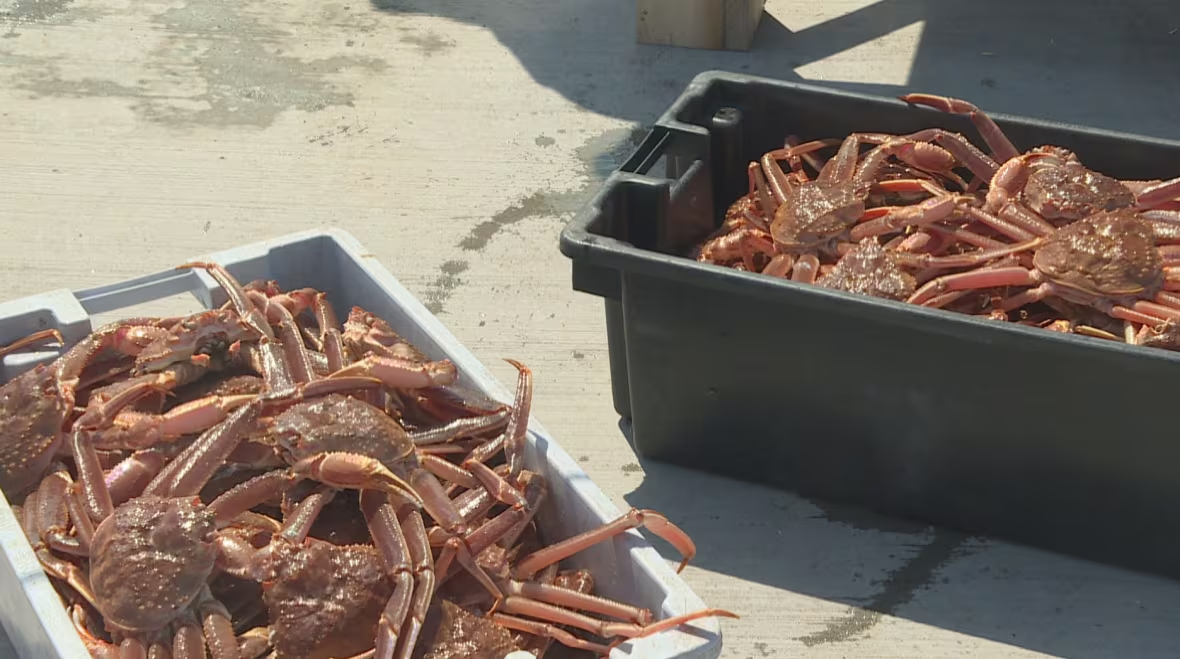Scientists and fishermen team up to help save North Atlantic right whale
More than 100 right whales spotted so far this year in busy Gulf of Saint Lawrence

Whale researchers and fishermen are out at sea together on a two-week mission, combining efforts to help save the endangered north Atlantic right whale.
These two worlds have usually stayed far apart, but for the first time scientists are onboard a crab boat to do their field work.
It's been a controversial fishing season in northern New Brunswick.
Whale protection efforts caused many fishing areas in the Gulf of St. Lawrence to be closed off, angering fishermen who saw it as an attack on their livelihood — some even taking to protest.
- Underwater robots tracking right whales and their prey
- North Atlantic right whale disentangled 1 week after being spotted
Crab fisherman Martin Noel, captain of the Jean-Denis Martin boat in Shippagan, agreed to take scientists out in the gulf to help them carry out their research this year.
"We don't want to be called whale killers," Noel said. "We want to be called fishermen that are implicated in the solution."
All season, fishermen begged Ottawa to involve them in fisheries management. They felt the federal government was imposing overly strict measures without consultation with industry.

Noel hopes this is a first step toward coming up with protection measures that aren't so damaging to the Acadian Peninsula's fishing industry.
"If we can help to mitigate, or just arrive at a certain point that we can fish even when whales are present, that would be the ultimate goal," he said.
'Nobody wants to put fishermen out of business'
Joining Noel are researchers from the New England Aquarium who have driven all the way from Boston to Shippagan.
Amy Knowlton, lead scientist, said she understand Noel and other fishermen's frustrations.
"Nobody wants to put fishermen out of business," she said. "But I think we also don't want to see the species go extinct."

Knowlton said up until now, closures have been the only option, but she thinks ropeless fishing — which she researches, and reduced breaking strength rope are the future.
She said that would allow fishermen to go even in areas where right whales are present.
"I think going forward what needs to happen is to make every gear set out there safe for whales," Knowlton said.
According to Noel, having that technology aboard every fishing vessel is still five to ten years away.
Whale catalog
Knowlton and her team from the aquarium are on the trip to find and photograph right whales.
They will look for any evidence of scarring from human interaction, assess their general health, how they socialize with one another — all part of trying to understand their behaviour in the gulf.
Twelve right whales were killed in the gulf in 2017, many struck by ships or caught in fishing gear. Knowlton suspects they are here to stay.
The National Oceanic and Atmospheric Administration reports a minimum number of individual 134 North Atlantic Right Whales has been sighted swimming in the southern Gulf of St. Lawrence.

"There's a lot of them here, there's many more than anybody ever knew were here," she said.
That's why she is glad to be partnering with fishermen like Noel.
"He educates us about how the fishing activity works, and we educate him about the right whales and how they live. It's been a very valuable connection," Knowlton said.
Her group — the Anderson Cabot Centre for Ocean Life at the New England Aquarium, carries the North Atlantic right whale photo identification catalog. Individual right whales seen during the trip will be added there.
Plankton work
A team from Dalhousie University is also on board to study the whale's food source: plankton.
They are collecting samples to determine where patches are found and what species whales are attracted to.
"The idea is we do this multiple times, in the presence of right whales, and in the absence of right whales," Hansen Johnson, PhD student said.

"It'll give us insight into which species and the abundance of these species are important for right whale feeding."
Hansen is also measuring ocean properties, like temperature and salinity, to understand what creates favourable conditions for right whale feeding — and what role climate change has played in bringing the whales to the gulf.
"If we know where their food is going to show up, we can be relatively confident that they will be there as well. And if we know that, then we can really direct more targeted efficient surveys and efficient management strategies to mitigate risks to the whales," he said.

